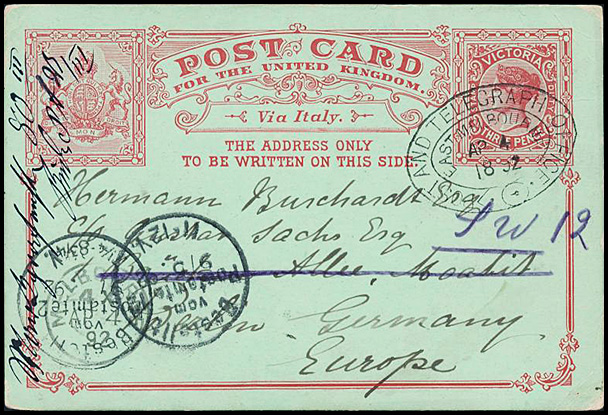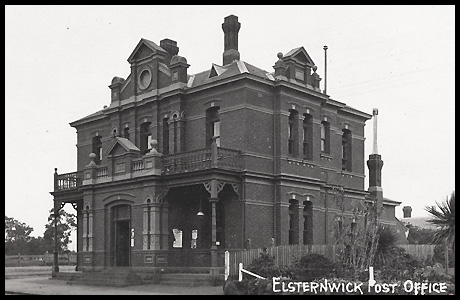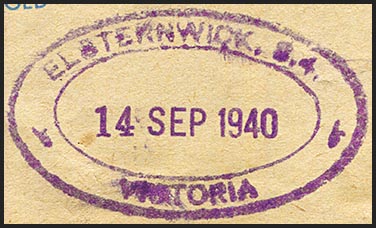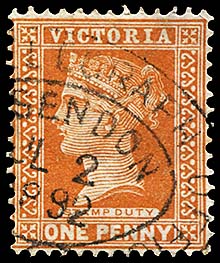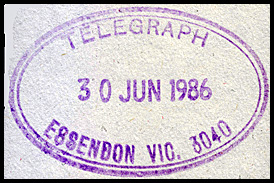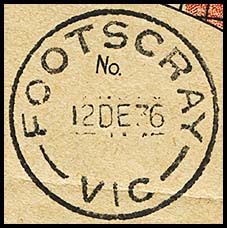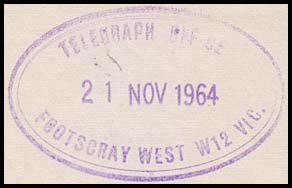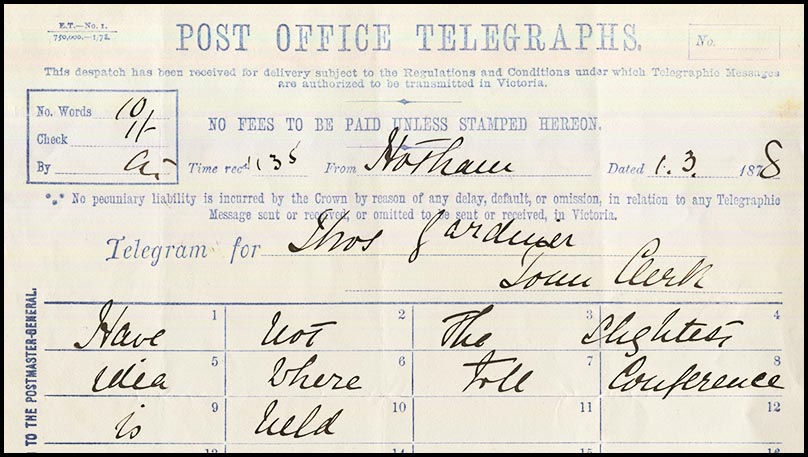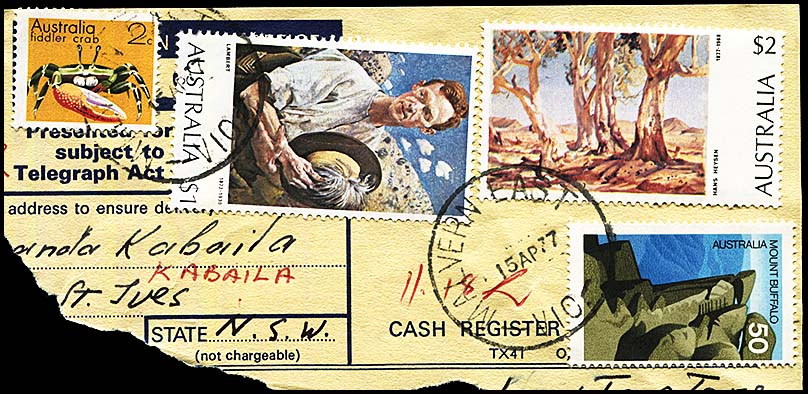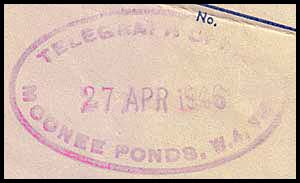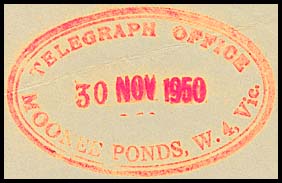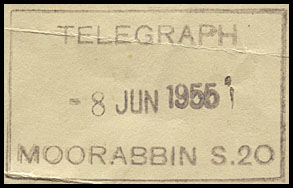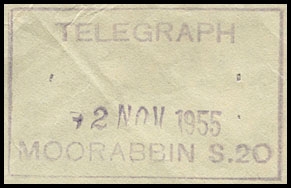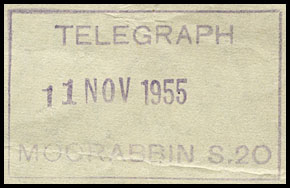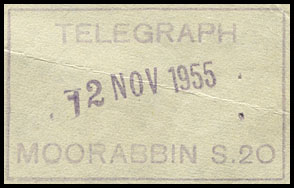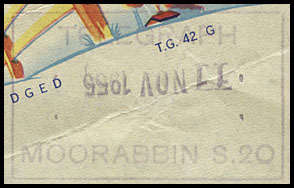Telegraph Offices on Suburban lines - D to M.
- Australia 1901-1988
- New South Wales
- Queensland
- South Australia
- Tasmania
- Victoria
- Western Australia
- International
- Special aspects
The following Telegraph Offices are included on this page:
| East Melbourne | Elsternwick | Elwood | Emerald Hill | Essendon |
| Fairfield | Fitzroy | Flemington | Flemington Racecourse | Footscray |
| Footscray West | Glenroy | Hotel Victoria | Hotham | |
| Kew | Malvern | Moonee Ponds | Moorabbin |
|
The Telegraph Office and the Post Office were opened on 1 August 1884 about 2.5 km east of the G.P.O. |
|
The office was issued with a 1 hole Belt & Buckle date stamp:
|
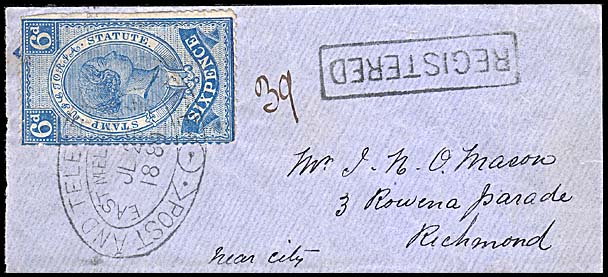 29 July 1889 (earliest recorded date). Only known complete cover with a Belt & Buckle cancelling a Stamp Statute. Provenance: Hugh Freeman, Johnstone. |
| East Melbourne 1 hole Belt & Buckle used in black on a cover to Waverley, Queensland. | 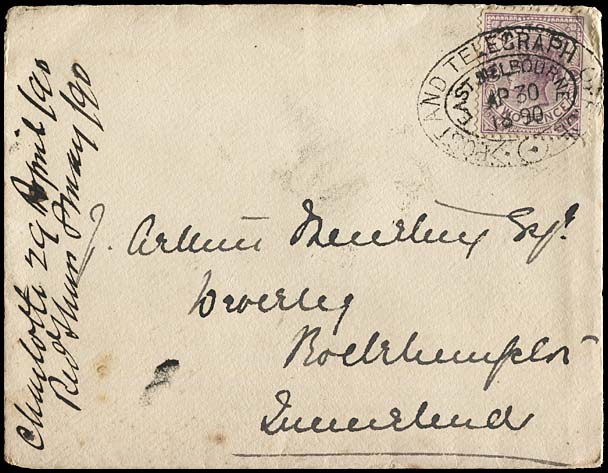 30 April 1890. One of only two complete covers with a Belt & Buckle used to an inter-Colonial destination. Provenance: Max Watson, Johnstone. |
| East Melbourne 1 hole Belt & Buckle used in black on an unaddressed Letter Card. | 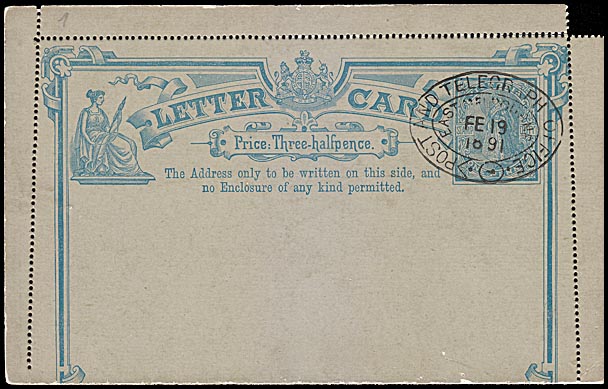 19 February 1891. |
East Melbourne 1 hole Belt & Buckle used in black on an embossed Post Card sent to Germany. Belt & Buckle has the date 4 April 1892 - so six months after Victoria joined the UPU - see below. This is one of four recorded items sent to an overseas destination with a Belt & Buckle date stamp.
|
|
Tied with two strikes of the East Melbourne Belt & Buckle date stamp in blue. Note this card was sent just before Victoria joined the UPU - see below. This is one of four recorded items sent to an overseas destination with a Belt & Buckle date stamp. |
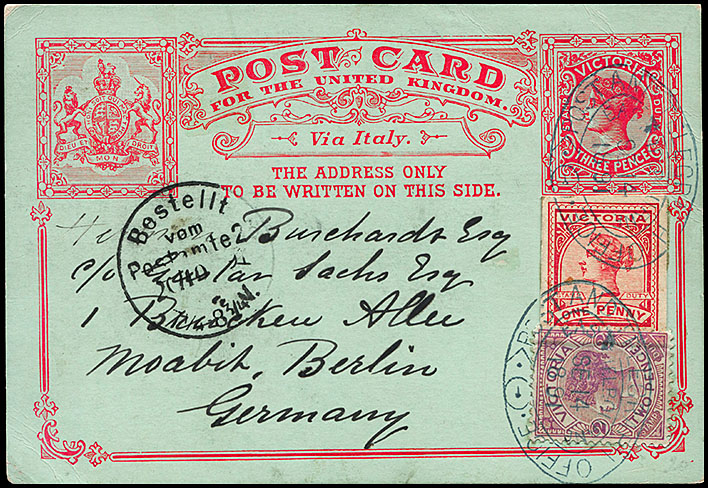 14 September 1891 - two strikes in blue. Same addressee as the previous Post Card. |
Torsten Weller noted that the 3d red postal card is inscribed "FOR THE UNITED KINGDOM VIA ITALY". It was sent to Germany and additionally franked with a 2d violet Naish and a 1d brown cut-out from a postal card to pay the 6d pre-UPU foreign ship latter rate. The concessional 2d or 3d postcard rates (depending on the route) only applied to cards sent to the United Kingdom. Postcard rates to other countries were not introduced until after Victoria joined the UPU in October 1891. Steig states (p.30) that "cards used during the correct period (prior to 1 October 1891) are very scarce. |
|
| The new Post and Telegraph Office was opened on 11 September 1891 (12 months after tendering) by the Premier (Mr. Munro) because the Postmaster-General (Mr. Duffy) was sick. Amongst the speeches, a reference to "the federation question" on the grounds of it being "within the range of practical politics". In another speech, the local Member (Mr. Bent) indicated "he was pledged to support (the Women's Franchise Bill) but if women had a vote he would support the granting of two votes to men" (The Argus). | 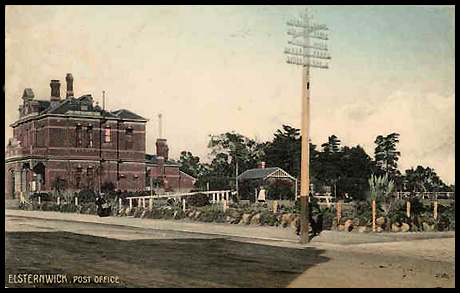 |
|
Elsternwick was issued with two types of date stamp for use with telegraphic matters:
|
||
|
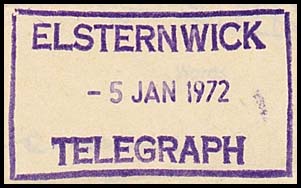 5 January 1972. Image by courtesy of Brian Sampson. |
|
A rectangular date stamp marked ELSTERNWICK but no inclusion of either TELEGRAPH or POST OFFICE.
|
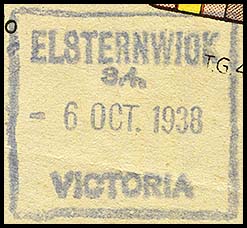 6 October 1938. Used on AB-GCF-34C. |
|
A rubber oval date stamp (RO3-ELSTERNWICK) marked ELSTERNWICK but no inclusion of either TELEGRAPH or POST OFFICE.
|
|
|
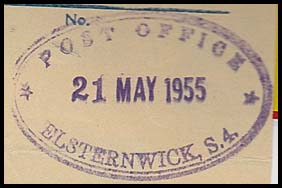 |
||
Postal date stamps were also applied telegrams:
|
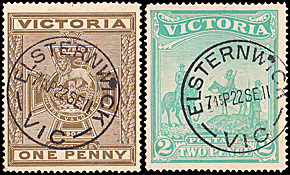 Standard Elsternwick date stamp (5 mm arcs). Diameter 28.5 mm. Applied (very late) to the two stamps in the 1900 Charity issue for the Patriotic Fund/Boer War. 22 September 1911. |
|
| Elwood.
The Post Office opened on 31 March 1914. |
|
| Three formats of a Post & Telegraph rubber date stamp were used at Elwood: | |
Used on AB-DO-8A. |
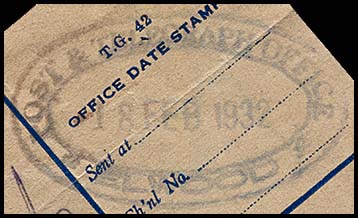 18 February 1932. |
2. RO6 - P&TO - ELWOOD.
|
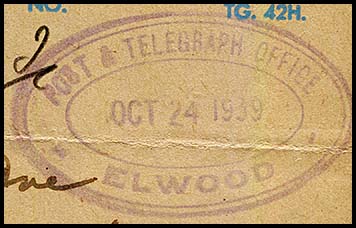 24 October 1939. Used on a Birthday Greetings Telegram (AB-GBF-39A). |
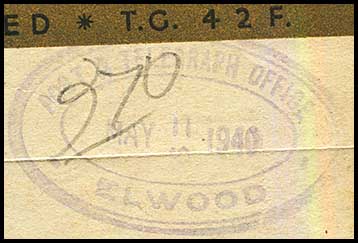 11 May 1940. Used on a Mother's Day Greetings Telegram (AB-GE-34). |
|
3. RO6-P&TO - ELWOOD S3.
|
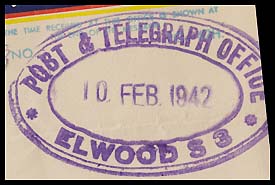 10 February 1942. Used on Birthday Greetings form AB-GBF-39B. |
|
The Leader of 3 June 1871 reported in local news that "Mr. Whiteman has always the interests of his constituents at heart. On Wednesday he gave notice of the following matter, which he intends bringing before the Chief Secretary on Tuesday. He intends then to call the attention of the hon. the Chief Secretary (in view of the increasing population and extension of the borough of Emerald Hill) to the desirability of a mid-day postal delivery and also of telegraphic communication being extended to that borough, and to ask if he will take any steps to have such accommodation afforded. The question is one that ought to get a favorable answer". The new Post and Telegraph Office opened in February 1872. On 9 March 1872, the Gazette listed the appointment of Mrs Aspinall as the Manager of the Electric Telegraph and Post Mistress at Emerald Hill. The Leader of 1 April 1876 reported "The establishment of telegraphic communication between the Melbourne Fire Brigade station and those of the suburbs, as recommended in The Age, has been initiated by the Town Council of Emerald Hill. On Wednesday they unanimously decided to adopt the suggestion and in the course of next week the necessary arrangements will probably bo completed". The Emerald Hill Post and Telegraph Office was relocated in October 1880 from the old building in Clarendon Street (which will now be sold) to the new Town Hall. The name of the Office was changed to South Melbourne on 21 November 1883. |
| Essendon.
The Telegraph Office was opened in August 1878 at the Railway Station. The Argus reported on 24 February 1881 that "a deputation from the borough of Essendon and Flemington introduced by Mr. Deakin M L A yesterday asked the Minister of Public Works as they were about to erect a new town hall, to pay £100 a year rental for a part of the building they designed for new Post and Telegraph Offices the Government at present pay £75 a year for a building. Mr Langridge said he would send an officer of the department to report on the subject, and let the deputation know the result". |
|||
| Essendon was issued with three types of date stamp for use with telegrams: | |||
|
|
||
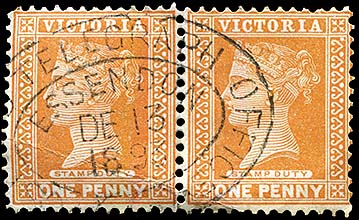 13 December 1893. |
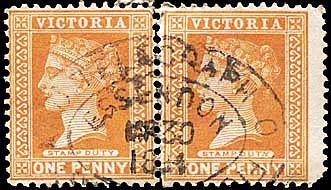 30 March 1894. |
||
|
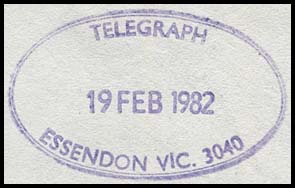 19 February 1982. |
||
|
|
||
A Post Office rubber oval date stamp was also used on telegrams.
|
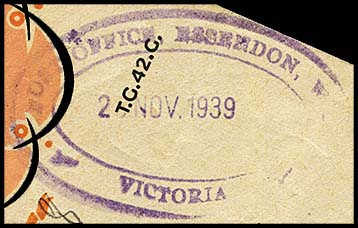 24 November 1939. Used on a 1954 Greetings telegram form AW-GSF-54C. |
||
| The usual postal date stamp was also used on telegrams. | 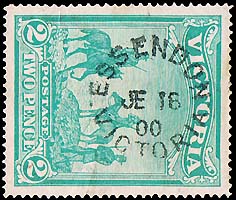 |
||
|
The Office was reclassified as a Post Office on 4 April 1887 having been opened as a Receiving Office on 21 February 1887. Details of the Telegraph Office are not known. Fairfield is about 7 km NE of the GPO and between two of the branches of the NE Suburban lines. |
|
Four formats of rubber TELEGRAPH OFFICE rubber date stamps are recorded and they were issued from 1971.
|
|
2. oval TELEGRAPH OFFICE with Flinders 3078 postcode at the base (RO2-TO). |
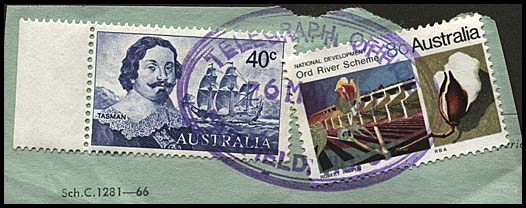 |
|
|
|
|
The Telegraph Office was opened in September 1877. The Argus of 28 February 1882 reported that "The Postmaster-General has urged the Minister of Public Works to immediately call for tenders for the erection of the new Post and Telegraph offices at Fitzroy and Carlton. Instructions will accordingly be given for the completion of the arrangements preliminary to the acceptance of the contracts without delay". Fitzroy was issued with three formats of date stamps for use with telegrams: |
|||
|
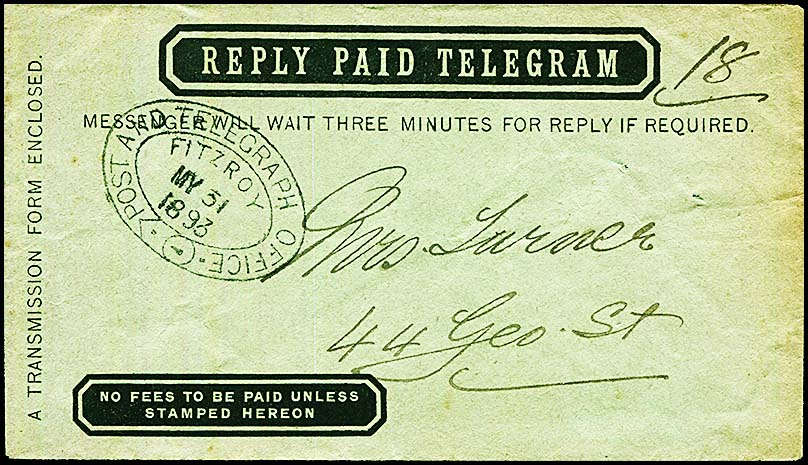 Used at Fitzroy 31 May 1893 on a Reply Paid Telegram delivery envelope (VC-ER-1). |
||
 16 December 1891 (earliest recorded date). |
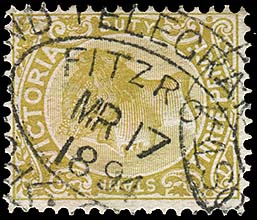 17 March 1894. Provenance: Hugh Freeman Johnstone. |
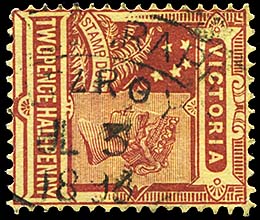 3 July 1896 (latest recorded date). |
|
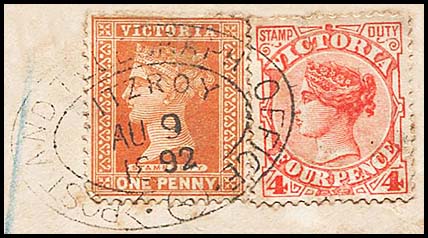 9 August 1892. One of two strikes on the front of a cover sent to Newtown, Sydney. Cover is in poor condition unfortunately. |
|||
|
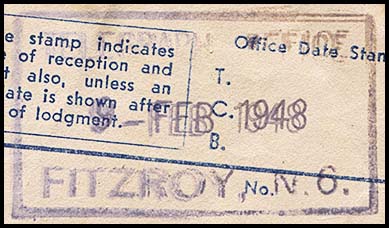 9 February 1948 (earliest recorded date). Used on AW-DO-10 (1945). |
||
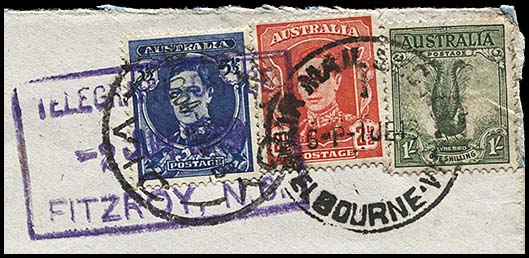 2 June 1948. Used on a delivery envelope to Leeds, England. |
|||
|
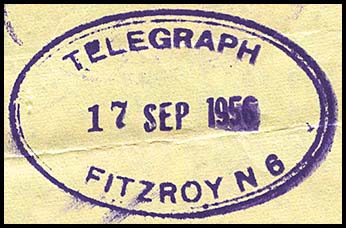 17 September 1956. Used on AW-GC-54B. |
||
Fitzroy North. The Telegraph Office was opened in April 1879. |
|||
Flemington. A Telegraph Office was opened at Flemington in about 1877 or in early 1878. The Argus of 8 April 1879 reported some problems: "The Postmaster General was yesterday waited on by a deputation from Flemington on the subject of the local Post and Telegraph arrangements at Flemington. The Post Office has been kept by Mr. Brady grocer and the Telegraph Office by Mr. James Chemist. Wishing to amalgamate the offices, the Postmaster General called for a departmental report. This report stated that, pending the erection of suitable premises by the Government, a portion of Mr James' place which could accommodate both the Post and Telegraph offices could be rented for £52 per annum. Also that Mr James' place was more central than Mr Brady's. The deputation yesterday urged that Mr. Brady's services be retained and protested against the alleged proposed appointment of Miss James - daughter of Mr. James - as Post and Telegraph Mistress on the ground that she was "only a new chum". Mr Patterson said he had been informed that Miss James had been in Victoria before her recent arrival here and that she had studied hard to qualify herself for a position in the Department. He had determined to amalgamate the two offices and to rent for that purpose portion of Mr James' premises. The Department would examine Miss James with a view to ascertaining her qualifications. In the meantime, an officer from Melbourne would be placed in charge of the combined offices. Mr. Brady was not acquainted with telegraphy and his services would not be retained". The Ovens and Murray Advertiser of 10 April reported "The Postmaster-General has cancelled the appointment of Miss James as Post and Telegraph mistress at Flemington, he having found that false representations have been made which induced him to confer the appointment to her". |
|
The running of the Queen's Plate (now called the Queen Elizabeth Stakes) in 1865 was a special occasion at Flemington. The winner was Volunteer. The event had to be cancelled in 1864 and 1866. The Gippsland Times of 8 November 1865 reported as follows:
|
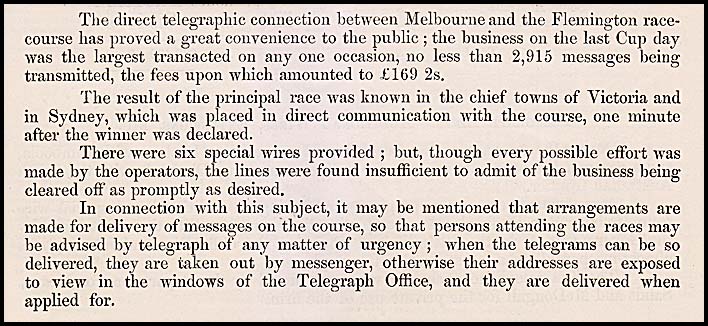 Report upon the Affairs of the Post Office and Telegraph Department for the Year 1880, p. 17. |
| Footscray.
The Telegraph Office was opened in October 1873.
|
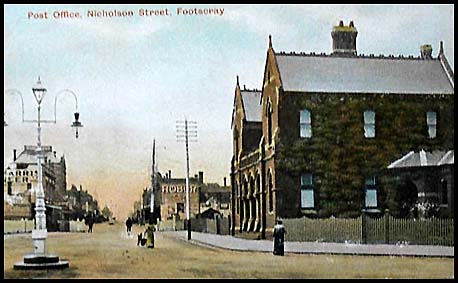 |
|
The Office was issued with three types of date stamp which were used with telegrams.
|
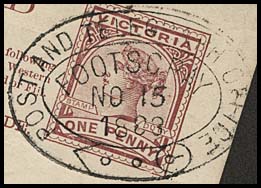 15 November 1893. |
|
| Commercial Bank of Australia PSE postcard to Carlton with Footscray 2 hole Belt & Buckle date stamp applied in black. | 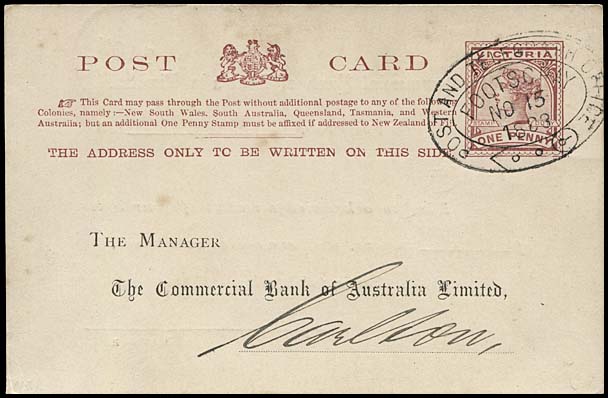 |
|
|
|
|
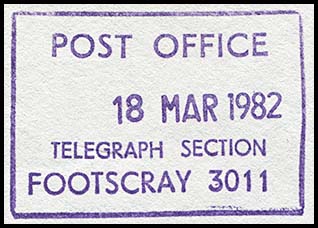 18 March 1982 - only recorded date. Date right justified. |
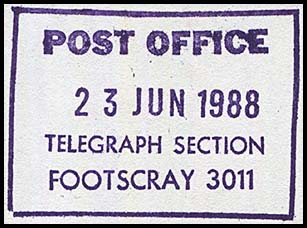 23 June 1988. D ate centered. |
|
Footscray West opened as a Post Office in December 1916 having been a Receiving Office since 15 April 1914. |
|
Two formats of rubber oval TELEGRAPH OFFICE date stamps were used:
|
Used on
AA-DO-13C. |
|
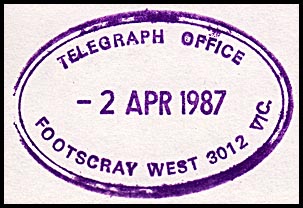 2 April 1987 (latest recorded date). |
| Glenroy.
The Telegraph Office
|
|
Three types of rubber TELEGRAPH OFFICE date stamps were issued to Glenroy for use with telegrams.
|
|
|
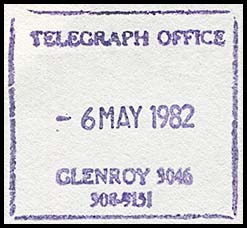 6 May 1982 (only recorded date). |
|
|
A Telegraph Office was established at the important Hotel Victoria in August 1893. Discussion of the possiblility was raised in a letter to the Editor of the Argus of 15 October 1892 (p. 10):
The letter obviously struck a chord because, about 11 months later, the Argus of 2 September 1893 reported:
No further information about the operation or a date stamp to be used for telegraphic work is known. The Australasian of 8 September 1906 (on page 36) did include an article and a photograph of the hotel:
The Post & Telegraph Office appears to have closed in 1919. |
| Hotham.
The Telegraph Office was opened in June 1875 while the combined Post and Telegraph Office was opened in July 1876. The Australasian of 24 October 1874 reported that "At the meeting of the Hotham Borough Council, held on Monday evening, a letter was read from the Department of Public Works stating that the Government were prepared to advance £1,500 to the Corporation for the erection of a courthouse and £l,000 for the erection of Post and Telegraph Offices in conjunction with the new Town Hall. The plans would require to be approved of by the department and the buildings be of the following dimensions: ... one general office room in the Post Office, 20ft by 35ft; stores and battery room, 15ft by 12ft; livingroom, 16ft by 34ft; two bedrooms, 15ft by 12 ft.; with kitchen, servant's room and necessary out-offices". The Argus of 10 July 1876 described
|
||
Early use. The earliest evidence of the operation of the Hotham Telegraph Office is a telegram delivery form (VC-DO-8B) used for a message transmitted from Hotham to Richmond on 1 March 1878. |
||
| The Hotham Office was issued with a 1 hole Belt & Buckle date stamp. | ||
|
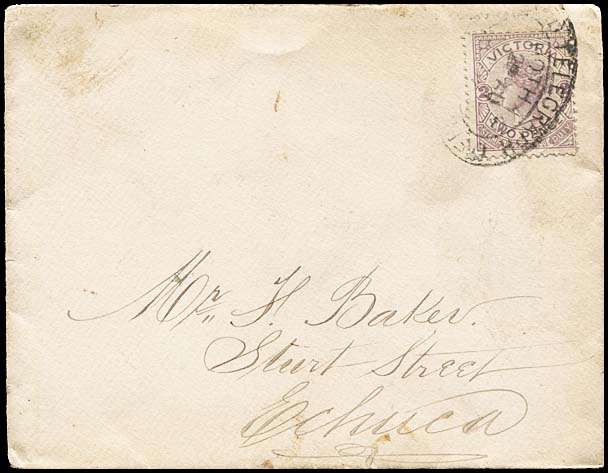 29 August 1887. |
|
| Kew.
The Telegraph Office was opened on 16 February 1875. The 1874 Annual Report noted "Poles have been extended from Hawthorn to Kew to which place a wire has been run." On 11 May 1881, the Argus reported that "The Postmaster General yesterday received a deputation from Kew with respect to the site of the new Post aud Telegraph offices at that place. They urged that land should be purchased for the new offices at the corner of Cotham road, near the Bull Inn that being the most central and convenient position. Mr Landridge said that he intended to purchase some land at that poiut for the new offices but as it was advisablo that the whole of the public offices should be together he suggested that the local authority should erect their new town hall and other public buildings on adjoining ground". The Lilydale Branch of the Melbourne NE line was constructed from Kew. |
|
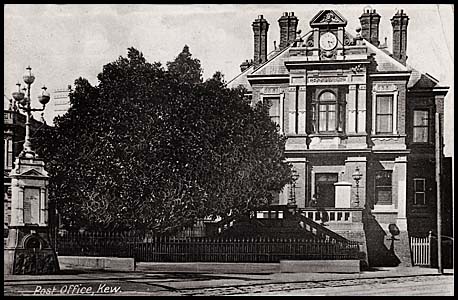 |
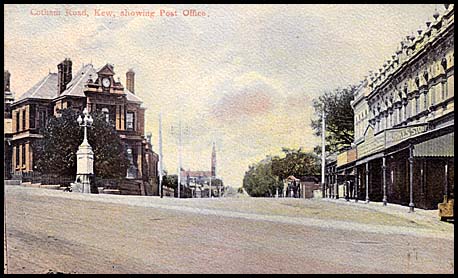 Kew Post & Telegraph Office on the corner of Cotham Road. |
Kew was issued with two formats of a circular rubber TELEGRAPH OFFICE date stamp for use with Telegrams.
|
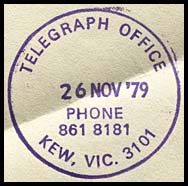 26 November 1979. Violet ink. |
 23 April 1985. Magenta ink. |
|
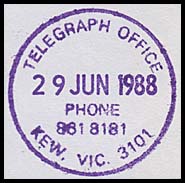 29 June 1988. |
|
A straight line hand stamp KEW was also used on telegrams and delivery envelopes.
|
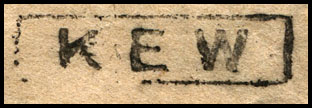 Used on AW-EU-8. |
|
The usual Post Office date stamp was also used on telegrams.
|
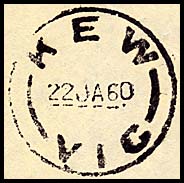 22 January 1960. Used on AA-DO-13B. |
|
An interesting event at Kew was reported in the Argus of 27 August 1878:
|
| Malvern. The Telegraph Office was opened on 5 January 1876. A test box at Malvern had significant responsibility for the Gippsland lines which either originated at Malvern or came from Oakleigh through that box at Malvern to Dandenong. |
||
The office was issued with an oval rubber date stamp (RO1 - TO).
|
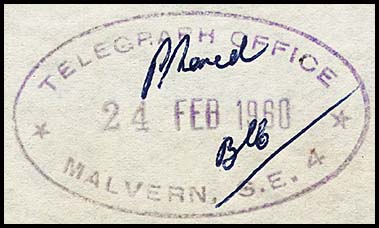 24 February 1960. Used on a delivery window envelope. |
|
The office was issued with a circular rubber date stamp which was used with magenta ink.
|
 18 May 1984. |
|
The Office was also issued with a rectangular rubber date stamp (RR1) with the only inscription apart from Malvern SE4 being VIC at the base.
|
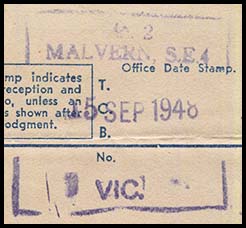 15 September 1948. Used on AW-DO-10B (45). |
|
|
||
| Moonee Ponds.
A Telegraph Station was appears to have been opened at Moonee Ponds Railway Station (year not known at present). The Station Mistress in 1879 saved a possibly major loss of life due to her quick actions. The Argus of 21 June 1879 recounts the incident in which the Moonee Ponds Station Mistress performed heroically and instantly. On 7 October 1887 "A deputation from the borough council of Essendon waited on the Postmaster-General and asked that a central post office and telegraph station should be erected on the public reserve, north of the Church of England, Moonee Ponds.
On 20 October 1888, the North Melbourne Advertiser reported:
By 1889, a decision still had not been made until the Department chose a site on the extreme west end of Puckle Street. A deputation of residents met to urge the decision to be reverse so that the new office might be in the main street (Mount Alexander Road) where it had been for the last 20 years. A new Post Office opened at Moonee Ponds on 3 March 1952 and it was intended to erect offices with similar designs at Brunswick West, Ascot Vale and Footscray West.
|
|
Two rubber oval TELEGRAPH OFFICE date stamps were issued to Moonee Ponds.
|
Used on AW-DO-10A (45). |
|
Used on AW-DO-10B (48). |
| Moorabbin.
A Post Office was established as Moorabbin with a change of name from South Brighton on 17 May 1909. A Telegraph Office was established soon after at the Post Office. Telegraph Offices had opened at East and South Brighton in July 1892. In July 1909 the telegraph lines between Moorabbin and East St. Kilda were blown down in a storm and interrupted communications for several hours. |
||
A rectangular horizontal TELEGRAPH rubber date stamp (RRH1-T) was issued to the Telegraph Office. It was used with both black and violet ink.
|
Used on AW-DO-10A (51). |
Used on AW-GC-54B. |
| The variations in the format of the letters in the date and the placement of the date show that the date was a separate hand-stamp.
Hence after the rectangular TELEGRAPH imprint had been made, the date would then have been added. |
Used on AW-GC-54B. |
Used on AW-GS-54A. |
Used on AW-GC-54B. |
||
